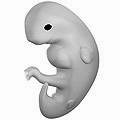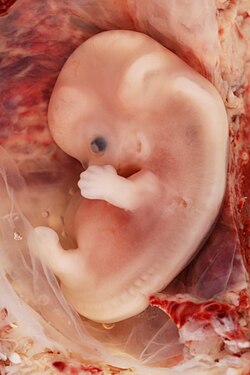Limb development
| Development of the limbs | |
|---|---|

Illustration of a human embryo at six weeks gestational age
|
|

9-week human embryo from ectopic pregnancy
|
|
|
Anatomical terminology
[]
|
Limb development in vertebrates is an area of active research in developmental biology. Limb formation begins in the morphogenetic limb field, as mesenchymal cells from the lateral plate mesoderm proliferate to the point that they cause the ectoderm above to bulge out, forming a limb bud. Fibroblast growth factor (FGF) induces the formation of an organizer at the end of the limb bud, called the apical ectodermal ridge (AER), which guides further development and controls cell death. Programmed cell death is necessary to eliminate webbing between digits.
The limb field is a region specified by expression of certain Hox genes a subset of homeotic genes and T-box genes; Tbx5 for forelimb and Tbx4 for hindlimb. Establishment of the limb field requires retinoic acid signaling in the developing trunk of the embryo from which the limb bud emerges.
Limb formation results from series of epithelial-mesenchymal inductions between the mesenchymal cells of the lateral plate mesoderm and the overlying ectodermal cells. Cells from the lateral plate mesoderm and the myotome migrate to the limb field and proliferate to create the limb bud. The lateral plate cells produce the cartilaginous and skeletal portions of the limb while the myotome cells produce the muscle components. The lateral plate mesodermal cells secrete fibroblast growth factors (FGF7 and FGF10) to induce the overlying ectoderm to form AER. The AER reciprocatively secretes FGF8 and FGF4 which maintains the FGF10 signal and induces proliferation in the mesoderm. The position of FGF10 expression is regulated by Wnt8c in the hindlimb and Wnt2b in the forelimb. The forelimb and the hindlimb are specified by their position along the anterior/posterior axis and possibly by two T-box containing transcription factors: Tbx5 and Tbx4, respectively.
...
Wikipedia
